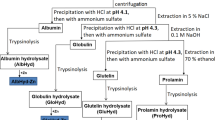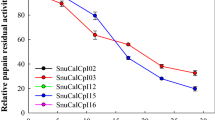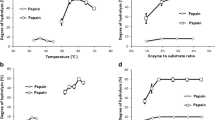Abstract
Designing new types of drugs with preferred properties against cancer is a great issue for scientists dealing with synthesis and study of biological activity. Several organometallic compounds used in chemotherapy reveal side effects. Peptides from edible sources having no side effects may play a transport role in the delivery of anticancer metal ions into targeted tumor cells. For the last two decades, peptide-metal complexes have been considered as potential anticancer agents. In this work, oxovanadium complexes of peptides from Chickpea (Cicer arietinum L.) seeds’ protein hydrolysate were investigated. The albumin fraction of Chickpea seeds protein was hydrolyzed with a combination of enzymes papain, trypsin, and alcalase. The hydrolysate was combined with vanadyl ions and obtained oxovanadium complexes were studied by FTIR, SEM–EDX, and TG-DSC analyses, and cell inhibition activity against A549 cells was detected by MTT Assay. In a result, activity of the complexes (IC50 = 14.39 µg/mL) increased 1.7-fold compared to the activity of inorganic salt of vanadium (IC50 = 24.75 µg/mL) against A549 cells. The complexes (CPH-V) were fractionated through Sephadex G-15, and the second active fraction, named CPH-V G15-II was studied by nano-Q-TOF LC/MS. Nine peptides with a molecular mass range of 437–1864 Da were identified. Seven of them were theoretically considered as cell-penetrating peptides. These results could serve first steps for deeper fundamental research on food-derived peptide-vanadium complexes.






Similar content being viewed by others
Abbreviations
- CPH:
-
Chickpea protein hydrolysate
- CPH-V:
-
Chickpea protein hydrolysate-vanadium
- SCLC:
-
Small-cell lung carcinoma
- NSCLC:
-
Non-small-cell lung carcinoma
- ACE:
-
Angiotensin converting enzyme
- DOX:
-
Doxorubicin
- EHT:
-
Electron high tension
- WD:
-
Working distance
- ICP-MS:
-
Inductively coupled mass spectrometry
- MTT:
-
3-(4,5-Dimethyl thiazolyl)-diphenyl tetrazolium bromide
- SD:
-
Standard deviation
References
Gallagher PE, Cook K, Soto-Pantoja D, Menon J, Tallant EA (2011) Angiotensin peptides and lung cancer. Curr Cancer Drug Targets 11:394–404
Jones GS, Baldwin DR (2018) Recent advances in the management of lung cancer. Clin Med (Lond) 18:s41–s46
Zhang H, Feng QQ, Gong JH, Ma JP (2018) Anticancer effects of isofraxidin against A549 human lung cancer cells via the EGFR signaling pathway. Mol Med Rep 18:407–414
Lee SH, Jaganath IB, Wang SM, Sekaran SD (2011) Antimetastatic effects of Phyllanthus on human lung (A549) and breast (MCF-7) cancer cell lines. PLoS ONE 6:e20994–e20994
Naik Bukke A, Nazneen Hadi F, Babu KS, Shankar PC (2018) In vitro studies data on anticancer activity of Caesalpinia sappan L. heartwood and leaf extracts on MCF7 and A549 cell lines. Data Brief 19:868–877
Lalitha LJ, Sales TJ, Prince P, Clarance PA, Kim YO, Mahmoud AH, Mohamed SE, Tack JC, Na SW, Kim HJ (2020) In-vitro phytopharmacological and anticancer activity of Loranthus Longiflorus Desv. Var. Falcatuskurz against the human lung cancer cells. J King Saud Univ Sci 32:1246–1253
Poornima P, Weng CF, Padma VV (2013) Neferine from Nelumbo nucifera induces autophagy through the inhibition of PI3K/Akt/mTOR pathway and ROS hyper generation in A549 cells. Food Chem 141:3598–3605
Doyen A, Beaulieu L, Saucier L, Pouliot Y, Bazinet L (2011) Demonstration of in vitro anticancer properties of peptide fractions from a snow crab by-products hydrolysate after separation by electrodialysis with ultrafiltration membranes. Sep Purif Technol 78:321–329
Beaulieu L, Thibodeau J, Bonnet C, Bryl P, Carbonneau M-E (2013) Evidence of anti-proliferative activities in blue mussel (Mytilus edulis) by-products. Mar Drugs 11:975–990
Conlon JM, Mechkarska M, Prajeep M, Arafat K, Zaric M, Lukic ML, Attoub S (2013) Transformation of the naturally occurring frog skin peptide, alyteserin-2a into a potent, non-toxic anti-cancer agent. Amino Acids 44:715–723
Treszl A, Schally AV, Seitz S, Szalontay L, Rick FG, Szepeshazi K, Halmos G (2009) Inhibition of human non-small cell lung cancers with a targeted cytotoxic somatostatin analog, AN-162. Peptides 30:1643–1650
Real Hernandez LM, Gonzalez de Mejia E (2019) Enzymatic production, bioactivity, and bitterness of chickpea (Cicer arietinum) peptides. Compr Rev Food Sci Food Saf 18:1913–1946
Wali A, Yanhua G, Ishimov U, Yili A, Aisa HA, Salikhov S (2020) Isolation and identification of three novel antioxidant peptides from the bactrian camel milk hydrolysates. Int J Pept Res Ther 26:641–650
Gupta N, Bhagyawant SS (2019) Impact of hydrolysis on functional properties, antioxidant, ACE-I inhibitory and antiproliferative activity of Cicer arietinum and Cicer reticulatum hydrolysates. Nutrire 44:5
Torres-Fuentes C, Alaiz M, Vioque J (2012) Iron-chelating activity of chickpea protein hydrolysate peptides. Food Chem 134:1585–1588
Liao W, Lai T, Chen L, Fu J, Sreenivasan ST, Yu Z, Ren J (2016) Synthesis and characterization of a walnut peptides-zinc complex and its antiproliferative activity against human breast carcinoma cells through the induction of apoptosis. J Agric Food Chem 64:1509–1519
Crans DC, Yang L, Haase A, Yang X (2018) Health benefits of vanadium and its potential as an anticancer agent. Met Ions Life Sci 18:251–279
Pessoa JC, Etcheverry S, Gambino D (2015) Vanadium compounds in medicine. Coord Chem Rev 301–302:24–48
Roy S, Mallick S, Chakraborty T, Ghosh N, Singh AK, Manna S, Majumdar S (2015) Synthesis, characterisation and antioxidant activity of luteolin–vanadium(II) complex. Food Chem 173:1172–1178
Sakurai H (2002) A new concept: the use of vanadium Complexes in the treatment of diabetes mellitus. Chem Rec 2:237–248
Agboola S, Ng D, Mills D (2005) Characterisation and functional properties of Australian rice protein isolates. J Cereal Sci 41:283–290
Rustamova N, Gao Y, Zhang Y, Yili A (2020) Biological activity of endophytic fungi from the roots of the medicinal plant Vernonia anthelmintica. Microorganisms 8:586
Bozorov K, Ma H-R, Zhao J-Y, Zhao H-Q, Chen H, Bobakulov K, Xin X-L, Elmuradov B, Shakhidoyatov K, Aisa HA (2014) Discovery of diethyl 2,5-diaminothiophene-3,4-dicarboxylate derivatives as potent anticancer and antimicrobial agents and screening of anti-diabetic activity: synthesis and in vitro biological evaluation. Part 1. Eur J Med Chem 84:739–745
Mijiti Y, Abulimiti A, Obulkasim A, Mirzaakhmedov SY, Ziyavitdinov DF, Yili A, Salikhov SI, Aisa HA (2019) Isolation and characterization of a new antimicrobial peptide from Pimpinella anisum seeds. Chem Nat Compd 55:914–917
Tamás MJ, Sharma SK, Ibstedt S, Jacobson T, Christen P (2014) Heavy metals and metalloids as a cause for protein misfolding and aggregation. Biomolecules 4:252–267
Derakhshankhah H, Jafari S (2018) Cell penetrating peptides: a concise review with emphasis on biomedical applications. Biomed Pharmacother 108:1090–1096
Miquel E, Alegría A, Barberá R, Farré R (2006) Casein phosphopeptides released by simulated gastrointestinal digestion of infant formulas and their potential role in mineral binding. Int Dairy J 16:992–1000
Scibior A, Pietrzyk L, Plewa Z, Skiba AJ (2020) Vanadium: risks and possible benefits in the light of a comprehensive overview of its pharmacotoxicological mechanisms and multi-applications with a summary of further research trends. J Trace Elem Med Biol 61:126508
Caetano-Silva ME, Netto FM, Bertoldo-Pacheco MT, Alegría A, Cilla A (2020) Peptide-metal complexes: obtention and role in increasing bioavailability and decreasing the pro-oxidant effect of minerals. Crit Rev Food Sci Nutr. https://doi.org/10.1080/10408398.2020.1761770
Dass CR, Choong PFM (2006) Carrier-mediated delivery of peptidic drugs for cancer therapy. Peptides 27:3020–3028
Chi Z, Zhu L, Lu X (2011) Comparison of two binuclear vanadium–catecholate complexes: synthesis, X-ray structure and effects in cancer cells. J Mol Struct 1001:111–117
Habala L, Bartel C, Giester G, Jakupec MA, Keppler BK, Rompel A (2015) Complexes of N-hydroxyethyl-N-benzimidazolylmethylethylenediaminediacetic acid with group 12 metals and vanadium—synthesis, structure and bioactivity of the vanadium complex. J Inorg Biochem 147:147–152
Mal SK, Chattopadhyay T, Fathima A, Purohit CS, Kiran MS, Nair BU, Ghosh R (2017) Synthesis and structural characterization of a vanadium(V)-pyridylbenzimidazole complex: DNA binding and anticancer activity. Polyhedron 126:23–27
Pugazhendhi A, Edison TNJI, Velmurugan BK, Jacob JA, Karuppusamy I (2018) Toxicity of Doxorubicin (Dox) to different experimental organ systems. Life Sci 200:26–30
Guardaro D, Keila Milán-Noris A, Serrano-Sandoval SN, Serna-Saldivar SO (2019) Chickpea proteins and peptides in health. In: Handbook of chickpeas: nutritional value, health benefits, and management, Chapter 4. NOVA Science Publishers, New York
Wang C, Wang C, Li B, Li H (2014) Zn(II) chelating with peptides found in sesame protein hydrolysates: identification of the binding sites of complexes. Food Chem 165:594–602
Wang L, Ding Y, Zhang X, Li Y, Wang R, Luo X, Li Y, Li J, Chen Z (2018) Isolation of a novel calcium-binding peptide from wheat germ protein hydrolysates and the prediction for its mechanism of combination. Food Chem 239:416–426
Fu T, Zhang S, Sheng Y, Feng Y, Jiang Y, Zhang Y, Yu M, Wang C (2020) Isolation and characterization of zinc-binding peptides from mung bean protein hydrolysates. Eur Food Res Technol 246:113–124
Udechukwu MC, Downey B, Udenigwe CC (2018) Influence of structural and surface properties of whey-derived peptides on zinc-chelating capacity, and in vitro gastric stability and bioaccessibility of the zinc-peptide complexes. Food Chem 240:1227–1232
Zhang Z, Zhou F, Liu X, Zhao M (2018) Particulate nanocomposite from oyster (Crassostrea rivularis) hydrolysates via zinc chelation improves zinc solubility and peptide activity. Food Chem 258:269–277
Dissanayake S, Denny WA, Gamage S, Sarojini V (2017) Recent developments in anticancer drug delivery using cell penetrating and tumor targeting peptides. J Control Release 250:62–76
Acknowledgement
This work was supported by the grants of the National Science and Technology Project “Major New Drug creation-Research and Development of New Drug varieties and its key Innovation Technology” (Project Number: 2017ZX09301045), “Tianshan Talent” Program of the Autonomous region in 2017, and the Central Asian Drug Discovery and Development Center of the Chinese Academy of Science, and CAS-TWAS President’s Fellowship Program. We also thank the PIFI foundation of CAS for visiting Scientist’s No. 2019VBA0013.
Funding
This study was supported by CAS-TWAS.
Author information
Authors and Affiliations
Corresponding author
Ethics declarations
Conflict of interest
The authors declare that they have no conflict of interest.
Additional information
Publisher's Note
Springer Nature remains neutral with regard to jurisdictional claims in published maps and institutional affiliations.
Rights and permissions
About this article
Cite this article
Mukhamedov, N., Wubulikasimu, A., Rustamova, N. et al. Synthesis and Characterization of Novel Chickpea Protein Hydrolysate-Vanadium Complexes Having Cell Inhibitory Effects on Lung Cancer A549 Cells Lines. Protein J 40, 721–730 (2021). https://doi.org/10.1007/s10930-021-09979-4
Accepted:
Published:
Issue Date:
DOI: https://doi.org/10.1007/s10930-021-09979-4




